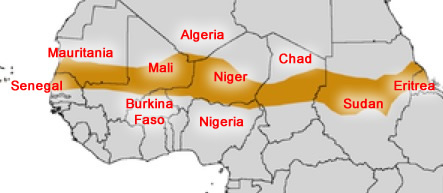Sahel
SAHEL (OR SAHIL) MEANS “edge or border” in Arabic. The Sahel is a semiarid transitional zone between the southern edge of the SAHARA DESERT and the humid savannah zone of Africa. On average it is 187 mi (300 km) wide. It has a fragile ecology but is also diverse in plant and animal species. The Sahel stretches across North Africa from the ATLANTIC OCEAN to SUDAN. Some geographers extend the Sahel to include the dry regions of ETHIOPIA, KENYA, and SOMALIA. It is a 3,107-mi- (5,000-km-) long belt of land across the entire African continent. It is an area into which the Sahara has been slowly expanding.
Where it merges with the Sahara, the rainfall drops to 7.9 in (20 cm). Where the Sahel merges with the humid savannas, rainfall has risen to 23.67 or 27.5 in (60 to 70 cm). The chief characteristic of the Sahel is its semiarid environment coupled with periodic droughts. Some geographers divide the Sahel into a broader, dryer northern zone and a wetter southern zone. The Sahel runs east and west through large parts of SENEGAL, MAURITANIA, MALI, BURKINA FASO, NIGER, NIGERIA, CHAD, Sudan, and then to the HORN OF AFRICA, including Ethiopia, ERITREA, DJIBOUTI, Kenya and Somalia. More specifically it runs through northern Senegal, southern Mauritania, to the great bend in the NIGER RIVER in Mali, then through Burkina Faso, Niger, Nigeria, Chad, and Sudan. Much of it is flat plains with great stretches located on elevated plateaus.

Beginning in the 1960s, serious droughts struck the Sahel. The area has been especially dry since 1968. Hundreds of thousands of people in the Sahel have died as a result of crop failures caused by drought. In the 1970s, the suffering of the people in the area attracted international attention.
The climate of the Sahel is normally arid. The rainfall varies, which makes agriculture difficult. Most of the vegetation is grasses and shrubs. The rain usually comes from June to September, though the average rainfall has been declining over the last five decades, which has allowed the Sahara to expand. Most of the people who live in the Sahel are nomadic herders. The drop in rainfall combined with overgrazing have contributed to increased DESERTIFICATION. Compounding the problems of the Sahel is the fact that populations are rapidly increasing. The population growth rates are some of the highest in the world. The total population of the Sahel countries is estimated to be around 50 million people excluding those counties east of Sudan. They are among the poorest in the world. The Sahel is also a religious transition zone between ISLAM in the north and traditional African and Christianity in the south.